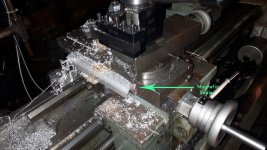I have for a long time wanted a dro on my Maximat V10P which is a very small lathe with very little room, and the extra challenge of the milling attachment at the rear. A couple of people appear to have done this successfully, using magnetic scales and quite small readers (like rls lm10).
Now, I was doing some tool post grinding on a cast iron job the other day, and the fine iron dust got me thinking - is this an issue for magnetic scales? Has anyone had problems with fine ferrous dwarf in conjunction with magnetic scales? And what about is I use a magnetic dial indicator base on the crossslide? Any issues?
As usual, grateful for any advice.
Roman
Now, I was doing some tool post grinding on a cast iron job the other day, and the fine iron dust got me thinking - is this an issue for magnetic scales? Has anyone had problems with fine ferrous dwarf in conjunction with magnetic scales? And what about is I use a magnetic dial indicator base on the crossslide? Any issues?
As usual, grateful for any advice.
Roman


